ITIL® Service Validation and Testing
Welcome to our blog on ITIL 4 Service Validation and Testing! We'll explore how this essential practice fits into the broader ITIL 4 framework, helping organisations deliver reliable IT services.
At the heart of ITIL 4 lies the focus on value co-creation and seamless service management. Service Validation and Testing play a pivotal role in ensuring that services meet customer expectations and align with business objectives. By collaborating with service design and business analysis practices, service validation specialists establish utility and warranty criteria for thorough testing. This involves manual and automated tests to identify and address potential risks early on, leading to cost savings and improved customer satisfaction.
Service Validation and Testing are crucial during the transition phase of a service's lifecycle. By validating the service design and meeting acceptance criteria, organisations gain confidence in their IT services' quality and compliance. Join us as we delve deeper into the world of ITIL 4 Service Validation and Testing and discover how it enhances the overall IT service management journey. Let's unlock the power of seamless and value-driven IT service delivery together!
What is ITIL Service Validation and Testing?
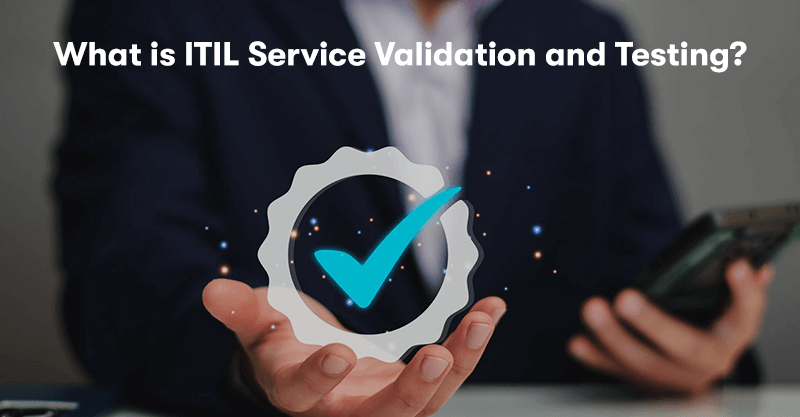
Service Validation and Testing is one of the ITIL 4 practices, and it plays a crucial role in ensuring that IT services meet the desired quality and performance standards before they are released into the production environment. The primary objectives of Service Validation and Testing include:
Validation of Service Design
It involves confirming that the service design aligns with the business and customer requirements and that all the necessary components are in place for successful service delivery.
Testing of Service Functionality
This phase involves conducting various tests to ensure that the service functions as expected and meets the specified functional requirements.
Verification of Non-Functional Requirements
In addition to functional requirements, IT services often have non-functional requirements related to performance, security, reliability, and other aspects. Service Validation and Testing verifies that these non-functional requirements are met.
Defect Identification and Correction
During testing, defects or issues may be identified. Service Validation and Testing helps in identifying these defects so that they can be addressed before the service goes live.
Confirmation of Readiness for Deployment
Once all tests are successfully completed, and any issues are resolved, Service Validation and Testing confirms whether the service is ready for deployment to the live environment.
Risk Assessment and Mitigation
The process involves assessing and mitigating risks associated with service deployment and ensuring that potential risks are minimised.
Service Validation Process Workflow
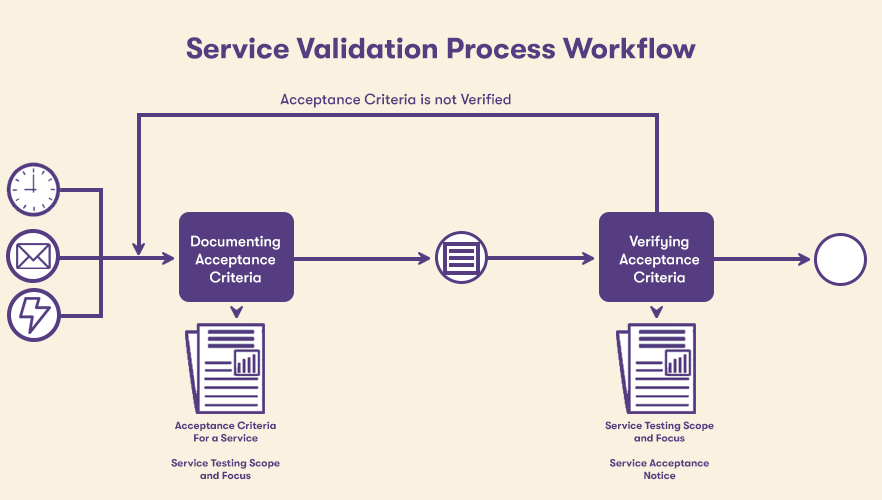
Documenting Acceptance Criteria
Throughout the design phase of a service solution delivery, the service validation specialist collaborates with the service design practice and business analysis practice to define utility and warranty criteria. These criteria must be tested and fulfilled for a service and its components to successfully pass the tests.
Verifying Acceptance Criteria
During the transition phase of a service solution delivery, the service validation specialist acknowledges and validates test results, ensuring that the acceptance criteria have been satisfactorily met for a specific test. This activity continues throughout the transition phase to provide assurance to stakeholders.
Test Process Workflow
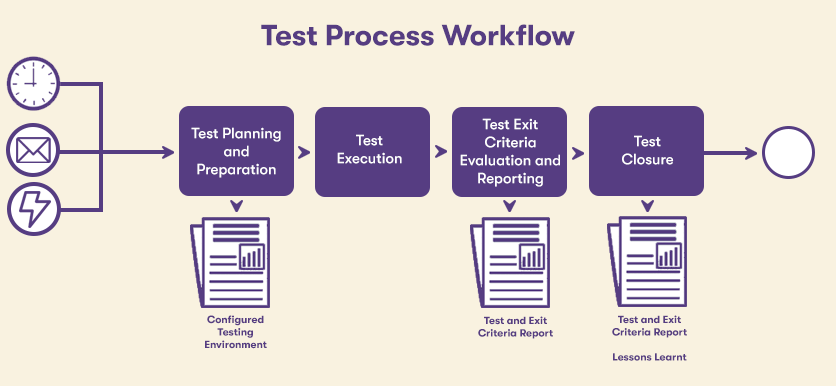
Test Planning and Preparation
The service testing manager examines the acceptance criteria for the service or product under testing. Subsequently, the manager devises a comprehensive test plan, considering the necessary environments, personnel, hardware, and other components essential for conducting the test in accordance with the overall testing strategy, standards, and relevant models.
Test Execution
The service testing specialist conducts manual or automated tests and carefully observes and records the resulting outputs.
Test Exit Criteria Evaluation and Reporting
The service testing specialist evaluates the test outcomes and determines whether the success criteria (or test exit criteria) have been fulfilled.
Test Closure
The service testing manager examines the test reports and, if mandated by the test model, formally approves the test completion.
What is the Objective of Service Validation and Testing?
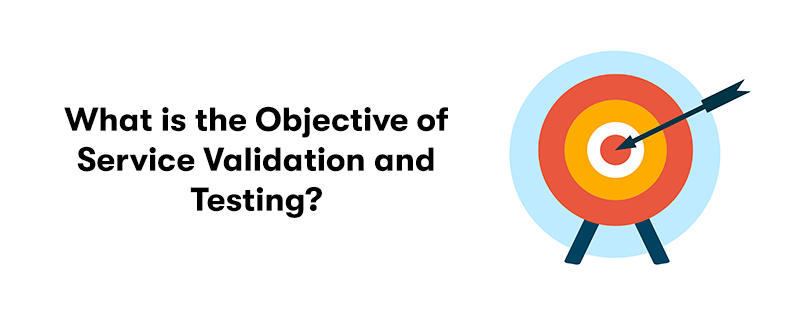
The objective of ITIL 4 Service Validation and Testing is to ensure that IT services meet the desired quality and performance standards before they are released into the production environment. The primary goal is to validate that the service design aligns with business and customer requirements, and that all the necessary components are in place for successful service delivery.
The specific objectives of ITIL 4 Service Validation and Testing include:
Validating Service Design
Confirming that the service design meets the intended requirements and that it aligns with the organisation's overall strategy and objectives. This ensures that the service is fit for purpose and will deliver value to the customers and stakeholders.
Testing Service Functionality
Conducting various tests to verify that the service functions as intended and meets the specified functional requirements. This involves testing different scenarios and use cases to ensure that the service behaves as expected.
Verifying Non-Functional Requirements
Many IT services have non-functional requirements related to performance, security, reliability, and other aspects. Service Validation and Testing ensures that these non-functional requirements are adequately verified and validated.
Identifying and Correcting Defects
During testing, defects or issues may be identified. The objective is to identify and address these defects before the service is deployed to the live environment. This minimises the risk of service disruptions and customer dissatisfaction.
Confirming Readiness for Deployment
Once all tests are successfully completed, and any issues are resolved, Service Validation and Testing confirms whether the service is ready for deployment. This confirmation is essential to ensure that the service will perform as expected in the live environment.
Assessing and Mitigating Risks
The process involves assessing and mitigating risks associated with service deployment. By identifying potential risks and addressing them proactively, the IT organisation can reduce the chances of service disruptions and ensure a smooth transition to the production environment.
Ultimately, the objective of ITIL 4 Service Validation and Testing is to provide confidence in the quality of IT services and to help deliver value to customers and the business. By thoroughly validating and testing IT services before they go live, organisations can minimise risks, reduce costly incidents, and improve overall service performance and customer satisfaction.
Why is Service Validation and Testing Important in ITIL?
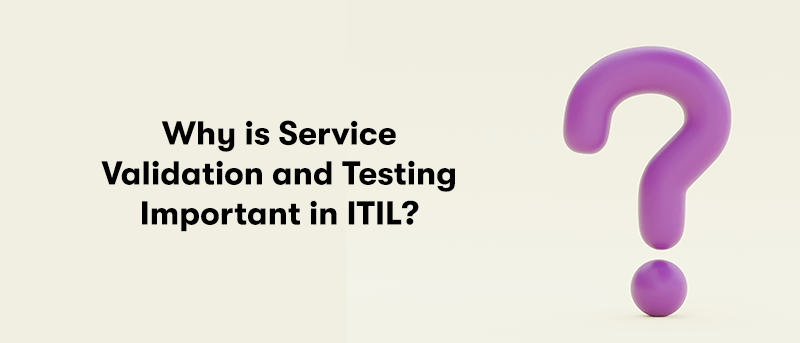
Service Validation and Testing in ITIL 4 play a critical role in ensuring that IT services are reliable, efficient, and capable of delivering value to the organisation and its customers. It helps build confidence in the services being offered and contributes to the overall success of IT service management practices.
Service Validation and Testing is essential in ITIL 4 for several reasons:
Quality Assurance
Service Validation and Testing ensure that IT services meet the specified quality standards and requirements. By thoroughly testing services before deployment, organisations can identify and address issues early, reducing the risk of service disruptions and costly incidents in the live environment.
Customer Satisfaction
Properly validated and tested services are more likely to meet customer expectations and deliver the intended value. When services perform as expected and without issues, customer satisfaction increases, leading to better relationships with clients and stakeholders.
Risk Reduction
Service Validation and Testing helps identify and mitigate potential risks associated with service deployment. By proactively addressing risks during testing, organisations can prevent major disruptions and avoid negative impacts on the business and customers.
Cost Savings
Early detection and resolution of defects and issues through testing can lead to cost savings. Fixing problems during the design and testing phases is generally less expensive than addressing them after deployment, where changes can be more complex and disruptive.
Compliance and Governance
ITIL 4 emphasises the importance of aligning IT services with regulatory requirements and governance frameworks. Service Validation and Testing play a role in ensuring compliance with relevant standards and regulations, contributing to a well-governed IT environment.
Continuous Improvement
Testing provides valuable feedback on the effectiveness and performance of IT services. By analysing test results and incorporating lessons learned, organisations can continuously improve their services and processes.
Confidence in Change Management
Before implementing changes in the production environment, ITIL 4 recommends testing those changes thoroughly. This ensures that potential negative impacts on the services are minimised, allowing organisations to have more confidence in their change management practices.
Alignment with Business Needs
Service Validation and Testing help verify that IT services align with the needs and expectations of the business. It ensures that services are fit for purpose and contribute to the overall business objectives.
Support for Agile and DevOps: ITIL 4 integrates with modern practices like Agile and DevOps. Service Validation and Testing can be adapted to work seamlessly with these methodologies, enabling faster and more efficient service delivery without compromising on quality.
What is Important to Understand about ITIL Service Validation and Testing?
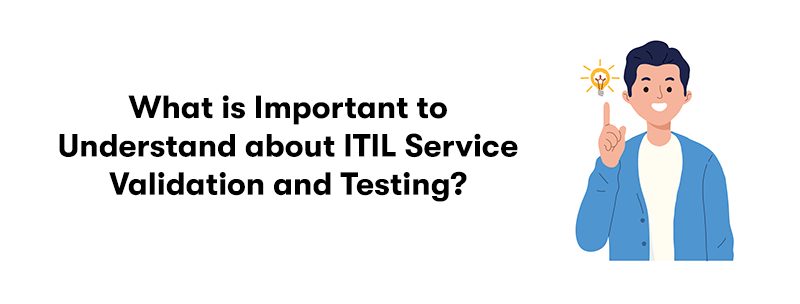
Several key points are important to understand about ITIL 4 Service Validation and Testing:
Integration with Service Design and Transition
Service Validation and Testing are integral parts of the service design and transition phases of the ITIL service lifecycle. It involves collaboration with service design and business analysis practices to ensure that services meet the required criteria before deployment.
Utility and Warranty
ITIL 4 introduces the concepts of utility and warranty for IT services. Utility refers to the functionality and features provided by a service, while warranty refers to its performance, reliability, and other non-functional aspects. Service Validation and Testing ensure that both utility and warranty criteria are met.
Identification and Mitigation of Risks
The process of testing services helps identify and mitigate potential risks associated with service deployment. By addressing these risks proactively, the likelihood of service disruptions and negative impacts on the business is reduced.
Compliance and Governance
Service Validation and Testing align with ITIL 4's emphasis on compliance with regulations and governance frameworks. Ensuring that services meet the required standards helps maintain a well-governed and compliant IT environment.
Manual and Automated Testing
Service testing can be conducted through manual or automated methods, or a combination of both. Automated testing allows for faster and more repeatable tests, while manual testing can provide more nuanced and exploratory analysis.
Validation of Service Design
Service Validation and Testing verifies that the service design aligns with business and customer requirements. It ensures that the service will deliver the intended value to stakeholders.
Continuous Improvement
The test results and lessons learned from Service Validation and Testing contribute to continuous improvement efforts. Organisations can use feedback from testing to refine their services and processes over time.
Support for Agile and DevOps
ITIL 4 is designed to work alongside modern methodologies like Agile and DevOps. Service Validation and Testing can be adapted to fit within these frameworks, enabling faster and more flexible service delivery.
Customer Satisfaction and Quality Assurance
Properly validated and tested services are more likely to meet customer expectations and deliver value. Service Validation and Testing provide quality assurance and help ensure customer satisfaction.
Test Exit Criteria
Service Validation and Testing involve setting specific test exit criteria, which are the conditions that must be met to conclude the testing phase. This ensures that tests are comprehensive and that services are ready for deployment.
Impact on Change Management
Testing plays a vital role in change management by verifying that proposed changes will not adversely affect the existing services. It provides the necessary confidence to proceed with changes in the production environment.
Understanding these aspects of ITIL 4 Service Validation and Testing will help IT organisations effectively implement testing practices and ensure the delivery of high-quality IT services that meet business needs and customer expectations.
Service Validation and Testing Roles and Responsibilities

In ITIL 4 Service Validation and Testing, there are specific roles and responsibilities to ensure that the testing activities are carried out effectively. These roles can vary depending on the organisation's size and complexity of services, but the key roles and their responsibilities typically include:
Service Testing Manager:
- Responsible for overseeing the entire service validation and testing process.
- Reviews the acceptance criteria for services or products being tested.
- Develops the overall testing strategy, standards, and applicable models.
- Plans, resources, environments, and schedules for testing activities.
- Ensures that testing aligns with business objectives and requirements.
- Approves test completion if required by the test model.
Service Testing Specialist:
- Executes the testing process and conducts manual or automated tests.
- Observes and records the test outputs and results.
- Analyses and validates the test results against acceptance criteria.
- Reports and communicates test findings to stakeholders.
- Identifies defects or issues and works with relevant teams to resolve them.
- Collaborates with other specialists to improve testing processes and methodologies.
Service Validation Specialist:
- Collaborates with the service design practice and business analysis practice.
- Helps establish utility and warranty criteria for the services to be tested.
- Ensures that the validation criteria align with business and customer requirements.
- Validates that the service design meets the intended quality and performance standards.
- Supports the testing team by providing insights into the service design and requirements.
Test Environment Manager:
- Ensures that the necessary test environments are set up and maintained.
- Coordinates with various teams to obtain the required hardware and software resources.
- Ensures that the test environments are consistent with the production environment where possible.
- Resolves issues related to test environment configurations and availability.
Test Analyst:
- Analyses requirements and translates them into test scenarios and test cases.
- Prepares and executes test scripts based on the test cases.
- Records and documents test results and defects.
- Assists in defect management and tracks the resolution progress.
- Reports test progress and status to the testing manager or relevant stakeholders.
Release Manager:
- Works closely with the testing team to plan and coordinate service releases.
- Ensures that tested and validated services are packaged for deployment.
- Coordinates the release schedule and manages deployment activities.
- Provides support during the service transition phase.
Change Manager:
- Collaborates with the testing team to assess and mitigate risks associated with proposed changes.
- Reviews test results and verifies that changes meet the required criteria before approval.
- Participates in the change advisory board (CAB) meetings and provides insights from testing activities.
Other Stakeholders:
Business Analysts, Service Designers, Developers, Operations Staff, and other relevant roles may also have specific responsibilities in the Service Validation and Testing process. Their involvement is crucial to ensure the overall success of the testing efforts.
It's important to note that the exact roles and responsibilities can be adapted and tailored to suit the organisation's specific needs and practices. Effective collaboration and communication between these roles are key to the successful implementation of Service Validation and Testing in ITIL 4.
Final Notes on Service Validation and Testing for ITIL
In conclusion, ITIL 4 Service Validation and Testing are vital pillars in ensuring the delivery of high-quality IT services. By collaborating with service design, business analysis, and other stakeholders, these roles play a crucial role in validating service design, mitigating risks, and achieving customer satisfaction. Whether it's manual or automated testing, the goal is to identify and resolve issues early, reducing the potential for disruptions in the live environment. With continuous improvement and alignment with modern methodologies like Agile and DevOps, Service Validation and Testing ensure that IT services meet business needs, compliance standards, and exceed customer expectations. Embrace these practices to drive success in your IT service management journey.



